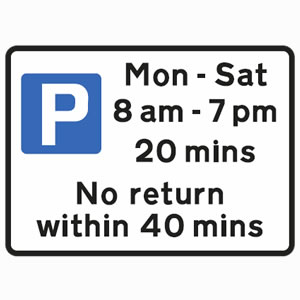Baffled By UK Parking Laws Maze?

If you’re struggling to distinguish between the rules of double and single yellow lines? We can tell you you’re not alone.
Or perhaps you’re puzzled over when exactly you’re permitted to park in a permit area without an actual permit?
Parking can often feel like a daunting maze in the UK.
Many of us who are in our 50s or older, passed our driving tests decades ago, and even though we all presume we are good drivers, many of us have forgotten all that stuff in the highway code!
We often hear from drivers, who have been driving for perhaps 30 or 40 years and are still baffled by some of the regulations – particularly around parking.
Which is the reason so many end up with parking tickets
So let’s try to unravel the rules of parking spaces and their often complex regulations
Let’s Start With The Easy Parking Rules
It goes without saying that a marked parking bay, either in a parking lot or roadside, is your safest bet for parking.
Look out for the large, white ‘P’ against a blue backdrop, typically displayed near the parking area and on directional signs.

Some parking bays are complimentary, while others demand a fee or may specify vehicle types.
Always ensure you review the signs for specifics about time limits or permit exclusions before bidding adieu to your car.
Like this sign below. You need to read these signs carefully. Although you may park here for free, you must note that it is only within specific times.

Another type of sign you need to be wary of when you’re choosing the place to park, is the example below.
As you’ll see this is quite a complicated-looking parking sign. And many people become confused by this.
It may appear at first glance to advertise free parking – but you need to note that the intention is you have to pay to park. (either by buying a ticket, or phoning).
You’ll also need to note they have a price structure, depending on the time of day you intend to park.

It’s important to note there is a 10 minutes grace .
This is to allow you a reasonable period after your parking time has finished to leave the car park. If you weren’t given this grace period, you may be able to challenge the charge. See the later section If you do not agree that you owe the parking charge for more information.
Parking outside of an established car park might be your only option sometimes, and that’s when the rules might get a tad intricate. Let’s break it down.
The Infamous Yellow Lines Dilemma
A double yellow line – whether it adorns the road or the kerb – is a clear indication that parking and waiting are strictly off-limits.
Seasonal restrictions might be signposted, and loading/unloading could be allowed if done continuously, barring any explicit restrictions.
Blue Badge holders enjoy a concession of three-hour parking on these double yellow lines, unless signage indicates otherwise.
Be mindful that a fine of typically £70 awaits those who flout these rules (although you will get a 50% reduction applicable if paid within a fortnight)
A single yellow line comes with a similar set of rules, albeit with restrictions often relaxed during evenings and weekends.
Single yellow lines mean no waiting or parking during the times shown on nearby signs or at the entrance to a controlled parking zone.
There are no standard times or rules, so ur always advised to check the signs before waiting or parking.
Red Route Lines Stopping Controls
In certain scenarios, you’ll encounter red lines replacing yellow ones. You won’t encounter them too often daily. However it’s important to know how to interpret them when you do come across them.
Unlike double yellow lines, there are virtually no exceptions to red route parking on double red lines.
That means no stopping, waiting, loading or picking up or setting down of passengers is permitted on red route double red lines.
Licensed taxis are permitted to drop off and pick up passengers on red route double red lines and disabled blue badge holders are permitted to pick up and set down disabled passengers on red route double red lines.
Understanding Clearways and Zig-Zag Lines
A red cross on a blue background indicates a clearway, implying no stopping at any time.
Parking or overtaking on white zig-zag lines is forbidden, as they obstruct visibility for pedestrians and incoming traffic. Yellow zig-zag lines demand a similar respect for prohibition.
Parking outside someone’s house is usually legal, as long as you don’t obstruct driveways or drop kerbs. Remember to check for resident parking permits or restrictions like yellow lines.
To Pavement Park or Not
While parking partially or wholly on the pavement in London is forbidden, in other regions, signs will dictate its legality. It’s key to remember that while it may not always be illegal, it can cause inconveniences to pedestrians, particularly those with mobility aids or pushchairs.
Highway Code on Road Parking
Adhering to the Highway Code may not be law, but violations of its rules can land you fines, penalty points, disqualification from driving, or even imprisonment.
Among other rules, it insists on parking close to the roadside, not facing against the traffic flow, and ensuring the engine, headlights, and fog lights are switched off before exiting your vehicle.
In essence, the art of parking is a balancing act between convenience and compliance. Navigate it wisely to avoid unnecessary fines and penalties.





